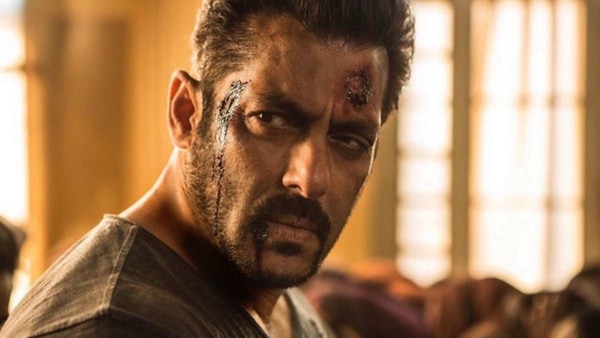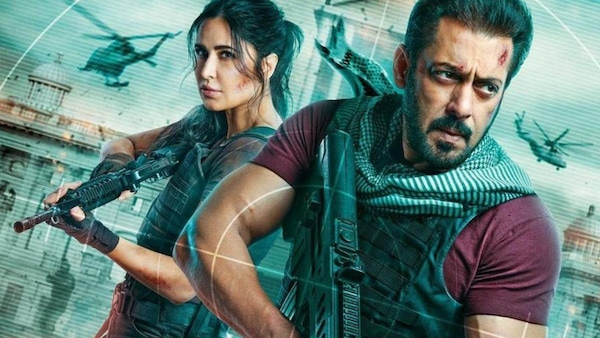Tiger 3: YRF's Salman Khan-Katrina Kaif Starrer Is Frustrating — & Rewarding
Tiger 3 awkwardly straddles the thin line between mindless fan service and engaging entertainer, and concludes as a little bit of both and neither.

Salman Khan as Tiger. YRF
Last Updated: 03.31 PM, Nov 12, 2023
This is #CriticalMargin, where Ishita Sengupta gets contemplative over new Hindi films and shows.
***
IN Tiger 3, the latest from the burgeoning Yash Raj Spy universe, Salman Khan jumps — a lot. He jumps from land to air, from air to land, and from land to water. He jumps from ropes, he jumps from helicopters, and sometimes he jumps because he can. All through, the actor maintains an eerie calm that can be best described as shoulder-slouching nonchalance. He hardly breaks a sweat, unlike Shah Rukh Khan in Pathaan (2023) who used his whole body to express injury. His stoicism single-handedly gives away the VFX deployed in a scene. With time, however, it has become a part of the legacy of Salman Khan, the actor, and Tiger, his enduring portrayal of an Indian agent who fell in love with a Pakistani spy and did more for international peace than the governments of both countries could do in seven decades.
Khan depicts him by flitting between extremes. Tiger doesn’t walk but flies, he doesn’t hit but hammers. He sobs when sad, and laughs aloud when happy. There is no in-between, resulting in a simplicity that both defines and outlines the character. As the first spy in an actively-expanding universe, Tiger is designed with a moving clarity that distinguishes him from his other two counterparts — the charming Pathaan and the captivating Kabir (War, 2019). Unsurprisingly, the franchise has been the most brazen about secularism through him even when the ideology is built into its core. Long before Pathaan fell for an ISI agent (Rubina played by Deepika Padukone), it was Tiger who paved the way by marrying one (Zoya played by Katrina Kaif) and leaving the country to be with her. It was he who foregrounded the idea of patriotism by refusing to conflate it with nationalism. Tiger conveyed the possibility of loving one’s country without living in it which also, inadvertently, underlines the hilarity of the taunts that command anyone who criticises India to leave it.
The third instalment, however, is the most ambivalent in the Tiger series so far. The film awkwardly straddles the thin line between mindless fan service and engaging entertainer, and concludes as a little bit of both and none at all. Directed by Maneesh Sharma, which in hindsight feels unnecessary, the outing reiterates and amps up the highlights established by the first two films in the franchise. Thus big action set pieces, none as ambitious as Pathaan, come at regular intervals and are often rewarding if the actor on screen is Kaif. There is a neatness with which she executes stunts which is both clinical and crafty. The film mines this by making space for a detailed hand combat scene where Kaif leaps and kicks wearing a towel. I have never seen a quieter theatre. Khan, on the other hand, prods on with signature indifference and refuses to even lip sync.
But what makes the globe-trotting Tiger 3 interesting and frustrating at once is the vagueness with which it operates. Written by Aditya Chopra (Shridhar Raghavan is credited for the screenplay), the film, like its previous iterations, envisions the possibility of mutual peace between the two warring nations. But it goes about by being brave and restrictive at the same time. During its runtime, Tiger 3 does more to dispel stereotypes than most Hindi films have done of late and, conforms (to) more than most Hindi films would have after going so far.

When a former ISI agent Aatish Rehman (an impressive Emraan Hashmi as the antagonist who goes to therapy) resurfaces and kidnaps Tiger and Zoya’s son, both are forced to follow his orders. They are instructed to retrieve certain codes from Turkey that could sabotage Pakistan’s nuclear power. While doing so, Tiger gets caught and is defamed as an attempt by India to infiltrate the intelligence of its neighbouring country. He is handed over to Pakistan and sentenced to be hanged. Using this as the premise, Tiger 3 delves into the socio-politics of Pakistan, addressing the tendency of military dictatorships to cast aside the elected government (the film opens in 1999 when the country witnessed its third military coup and General Pervez Musharaff came to power after overthrowing former prime minister Nawaz Sharif). By doing so, it differentiates between a government and an organisation, and more crucially, between a country and terrorism.
This is where things work. At a time when there is an onslaught of Hindi films seething with jingoism, Tiger 3 unfolds attuned to political nuances. It unravels mostly in Pakistan, a plucky move by every regard, and presents the government of the country as an entity eager to extend peace talks with India. The film jumps timelines, once in 2011 and another in 2023, and maintains this as the reality, suggesting that it is people like Rehman who upend such narratives for their own personal agenda.

When a mainstream Hindi film, headlined by one of the biggest superstars, does something like this, it walks miles in humanising a country which is increasingly being reduced to severe stereotypes and censured for being an ally to terrorism (consider Shyam Benegal’s Mujib, Sarvesh Mewara’s Tejas, and Raja Menon’s Pippa as examples). It is also oddly moving when Tiger states that his decision to help Pakistan’s government from being ousted by the military is informed by the fact that this is his in-law’s place. The moment lands more effectively than Gadar 2 could manage.
But for all its secular insights, Tiger 3 also ends up exalting India as the saviour of Pakistan. It is Tiger, and not so much Zoya, who is given the bigger fight and emerges as the guardian angel who aids in reinstating the democracy of the country. What is more troubling than this is, for a film so preoccupied with protecting democracy from the hands of dictatorship, it remains toothless when it comes to India, where a debate no different from the one depicted in the film, rages on with increasing fervour with each passing day.
Tiger 3 ends on a saccharine note, validating a troubling narrative that peace between India and Pakistan is possible only when one stoops a little, and it matters not if that is attained by reverence or force. When the particular scene played out in the theatre, everyone stood up instinctively. Like they had preempted the moment. Like they knew, much like the makers of Tiger 3, that everyone likes an amicable story as long as they are on the more powerful side.

 Premium
Premium